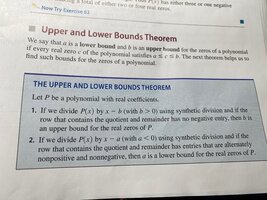In terms of the paper I referred to, my thinking was that DRS says that if there are no sign changes in the polynomial P(x) then there are no positive real roots and if there are no sign changes when testing P(−x) then there will be no real negative roots. So if a quotient contains all positive or all negative coefficients, then there will be no sign changes for higher/lower values of x. Still somewhat muddled mentally, but that's the idea I had.
I hadn't considered that you can use
Descartes' Rule of Signs itself (not its informal
proof, which is what you were implying) to prove the bounds theorem(s). Let's do that explicitly for both bounds. (I'll assume positive leading coefficient, and I won't worry about zero coefficients for simplicity.)
For the
upper bound, we assume that the quotient has all positive coefficients, and the remainder is positive. Then DRS applied to the quotient says that the quotient has no positive zeros; therefore the quotient times the divisor (x-c), plus the remainder, will be positive for all x>c.
How about the
lower bound? Here we divide by (x-c) where c is negative, and assume that the quotient has alternating signs, and the remainder continues the pattern. I think we need to consider two cases.
If the
degree is odd, then there are an
even number of coefficients, which will be +-...+-, so the remainder will be
positive. DRS says that the quotient has no negative zeros, and the positive leading term implies its graph falls to the left, so it is negative for all x<c. Thus, for x<c, we have a negative quotient times a negative divisor, plus a positive remainder, and the result is always positive, and never zero.
If the
degree is even, then there are an
odd number of coefficients, which will be +-...+-+, so the remainder will be
negative. DRS says that the quotient has no negative zeros, and the positive leading term implies its graph rises to the left, so it is positive for all x<c. Thus, for x<c, we have a positive quotient times a negative divisor, plus a negative remainder, and the result is always negative, and never zero.
I haven't tried to make it a complete proof, but it seems to work.
I'm still struggling with the intuition behind the lower bound rule, though. The upper bound completely makes sense. I used your example above of
(x−c)Q(x) where
Q(x) has all positive coefficients with values that are increasingly greater than
c and see why it would hold.
I think one of my confusions is that according to DRS, sign changes indicate possible roots. So why does the alternating positive/negative indicate a lower bound. I'm still not getting the intuition behind the lower bound.
My original idea was to do the same approach we use for DRS to prove the alternating signs case using the positive signs case. Given that the latter is true, f(-x) will have the same sign, therefore no positive zeros; so f(x) has no negative zeros. But it does take a little juggling to handle the details, probably involving the same two cases as above.
I suspect you are being confused by that first page of the paper, which misleadingly relates sign changes from one coefficient to the next with zeros. That connection is not so direct; and the intuition it provides is nothing like a proof.
As for textbooks, some put proofs of major theorems in an appendix where the better students, who can benefit from them, can find them; but even those often have to just give a brief summary of a proof that is beyond that level. Links to online sources could be helpful in such cases.

